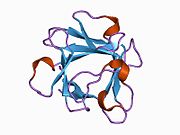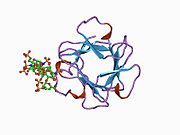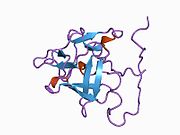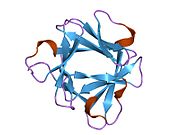Basic fibroblast growth factor
Ensembl | |||||||||
|---|---|---|---|---|---|---|---|---|---|
| UniProt | |||||||||
| RefSeq (mRNA) | |||||||||
| RefSeq (protein) | |||||||||
| Location (UCSC) | Chr 4: 122.83 – 122.9 Mb | Chr 3: 37.4 – 37.46 Mb | |||||||
| PubMed search | [3] | [4] | |||||||
| View/Edit Human | View/Edit Mouse |
Fibroblast growth factor 2, also known as basic fibroblast growth factor (bFGF) and FGF-β, is a
Function
Like other FGF family members, basic fibroblast growth factor possesses broad
In normal tissue, bFGF is present in
It has been hypothesized that, during both
In addition, it is synthesized and secreted by human
FGF2 has been shown in preliminary animal studies to protect the heart from injury associated with a heart attack, reducing tissue death and promoting improved function after reperfusion.[10]
Recent evidence has shown that low levels of FGF2 play a key role in the incidence of excessive anxiety.[11]
Additionally, FGF2 is a critical component of human
FGF2 is synthesized primarily as a 155 amino acid polypeptide, resulting in an 18 kDa protein. However, there are four alternate start codons which provide N-terminal extensions of 41, 46, 55, or 133 amino acids, resulting in proteins of 22 kDa (196 aa total), 22.5 kDa (201 aa total), 24 kDa (210 aa total) and 34 kDa (288 aa total), respectively.[7] Generally, the 155 aa/18 kDa low molecular weight (LMW) form is considered cytoplasmic and can be secreted from the cell, whereas the high molecular weight (HMW) forms are directed to the cell's nucleus.[17]
Since its first isolation from the bovine pituitary,[18] FGF2 has become a prominent signaling protein studied in bovine reproduction. It has been found in cumulus cells that surround the oocyte and evidence on such early reproductive function indicates FGF2 may promote meiotic resumption and prevent cumulus cell apoptosis.[19] FGF2 is also produced by the uterine epithelium, secreted into the lumen, and acts on the developing embryo and conceptus. Work in mice previously established that FGF2 plays a role in primitive endoderm (PE) development.[20] Research with bovine embryos has since noted this same phenomenon. Extended blastocyst cultures with FGF2-supplemented media observed that FGF2 increases PE outgrowths via proliferation. Knockout models of the FGF receptor and its kinase activity appears to alter the cellular expression of NANOG and GATA4 (transcription factors essential for proper cell differentiation and embryonic development), indicating a specific role of FGF2 in PE specification and subsequent blastocyst development rates.[20][21] Culture media supplemented with combinations of FGF2, EGF and IGF2 have found similar results and indicate that FGF2 may activate the AKT pathway for trophoblastic cell line growth.[22] Together, this showcases the key roles FGF2 plays in bovine embryo development, as similarly described in other mammalian species.
Interactions
Basic fibroblast growth factor has been shown to
See also
- Angiogenesis
- Anxiety disorders
- Cytokine
- Fibroblast growth factor
- Growth factor
- Proteases in angiogenesis
- Receptor (biochemistry)
- Signal transduction
References
- ^ a b c GRCh38: Ensembl release 89: ENSG00000138685 – Ensembl, May 2017
- ^ a b c GRCm38: Ensembl release 89: ENSMUSG00000037225 – Ensembl, May 2017
- ^ "Human PubMed Reference:". National Center for Biotechnology Information, U.S. National Library of Medicine.
- ^ "Mouse PubMed Reference:". National Center for Biotechnology Information, U.S. National Library of Medicine.
- PMID 1697263.
- S2CID 33214466.
- ^ S2CID 45425517.
- PMID 2549857.
- S2CID 2305986.
- S2CID 14251918.
- PMID 19439615.
- PMID 11108268.
- PMID 16753134.
- PMID 23206696.
- PMID 26334535.
- ^ PMID 32383752.
- PMID 24780002.
- PMID 32498439.
- PMID 30887159.
- ^ PMID 21778141.
- PMID 21295834.
- PMID 26304178.
- PMID 12145206.
- PMID 9826564.
- PMID 11716516.
Further reading
- Ornitz DM, Itoh N (2001). "Fibroblast growth factors". Genome Biology. 2 (3): REVIEWS3005. PMID 11276432.
- Orpana A, Salven P (February 2002). "Angiogenic and lymphangiogenic molecules in hematological malignancies". Leukemia & Lymphoma. 43 (2): 219–24. S2CID 21908151.
- Marie PJ, Debiais F, Haÿ E (2003). "Regulation of human cranial osteoblast phenotype by FGF-2, FGFR-2 and BMP-2 signaling". Histology and Histopathology. 17 (3): 877–85. PMID 12168799.
- Zhao XC, Zhang LM, Tong DY, An P, Jiang C, Zhao P, Chen WM, Wang J (March 2013). "Propofol increases expression of basic fibroblast growth factor after transient cerebral ischemia in rats". Neurochemical Research. 38 (3): 530–7. PMID 23247820.
- Vincent T, Saklatvala J (June 2006). "Basic fibroblast growth factor: an extracellular mechanotransducer in articular cartilage?". Biochemical Society Transactions. 34 (Pt 3): 456–7. PMID 16709186.
- Ribatti D, Vacca A, Rusnati M, Presta M (2007). "The discovery of basic fibroblast growth factor/fibroblast growth factor-2 and its role in haematological malignancies". Cytokine & Growth Factor Reviews. 18 (3–4): 327–34. PMID 17537668.
- Watson R, Anthony F, Pickett M, Lambden P, Masson GM, Thomas EJ (September 1992). "Reverse transcription with nested polymerase chain reaction shows expression of basic fibroblast growth factor transcripts in human granulosa and cumulus cells from in vitro fertilisation patients". Biochemical and Biophysical Research Communications. 187 (3): 1227–31. PMID 1417798.
- Zhu X, Komiya H, Chirino A, Faham S, Fox GM, Arakawa T, Hsu BT, Rees DC (January 1991). "Three-dimensional structures of acidic and basic fibroblast growth factors". Science. 251 (4989): 90–3. PMID 1702556.
- Eriksson AE, Cousens LS, Weaver LH, Matthews BW (April 1991). "Three-dimensional structure of human basic fibroblast growth factor". Proceedings of the National Academy of Sciences of the United States of America. 88 (8): 3441–5. PMID 1707542.
- Ago H, Kitagawa Y, Fujishima A, Matsuura Y, Katsube Y (September 1991). "Crystal structure of basic fibroblast growth factor at 1.6 A resolution". Journal of Biochemistry. 110 (3): 360–3. PMID 1769963.
- Zhang JD, Cousens LS, Barr PJ, Sprang SR (April 1991). "Three-dimensional structure of human basic fibroblast growth factor, a structural homolog of interleukin 1 beta". Proceedings of the National Academy of Sciences of the United States of America. 88 (8): 3446–50. PMID 1849658.
- Wu DQ, Kan MK, Sato GH, Okamoto T, Sato JD (September 1991). "Characterization and molecular cloning of a putative binding protein for heparin-binding growth factors". The Journal of Biological Chemistry. 266 (25): 16778–85. PMID 1885605.
- Fukushima Y, Byers MG, Fiddes JC, Shows TB (1991). "The human basic fibroblast growth factor gene (FGFB) is assigned to chromosome 4q25". Cytogenetics and Cell Genetics. 54 (3–4): 159–60. PMID 2265560.
- Lafage-Pochitaloff M, Galland F, Simonetti J, Prats H, Mattei MG, Birnbaum D (1990). "The human basic fibroblast growth factor gene is located on the long arm of chromosome 4 at bands q26-q27". Oncogene Research. 5 (3): 241–4. PMID 2320377.
- Story MT, Esch F, Shimasaki S, Sasse J, Jacobs SC, Lawson RK (February 1987). "Amino-terminal sequence of a large form of basic fibroblast growth factor isolated from human benign prostatic hyperplastic tissue". Biochemical and Biophysical Research Communications. 142 (3): 702–9. PMID 2435284.
- Kurokawa T, Sasada R, Iwane M, Igarashi K (March 1987). "Cloning and expression of cDNA encoding human basic fibroblast growth factor". FEBS Letters. 213 (1): 189–94. S2CID 28111330.
- Prats H, Kaghad M, Prats AC, Klagsbrun M, Lélias JM, Liauzun P, Chalon P, Tauber JP, Amalric F, Smith JA (March 1989). "High molecular mass forms of basic fibroblast growth factor are initiated by alternative CUG codons". Proceedings of the National Academy of Sciences of the United States of America. 86 (6): 1836–40. PMID 2538817.
- Florkiewicz RZ, Sommer A (June 1989). "Human basic fibroblast growth factor gene encodes four polypeptides: three initiate translation from non-AUG codons". Proceedings of the National Academy of Sciences of the United States of America. 86 (11): 3978–81. PMID 2726761.
- Abraham JA, Whang JL, Tumolo A, Mergia A, Fiddes JC (1987). "Human basic fibroblast growth factor: nucleotide sequence, genomic organization, and expression in mammalian cells". Cold Spring Harbor Symposia on Quantitative Biology. 51 Pt 1: 657–68. PMID 3472745.
- Sommer A, Brewer MT, Thompson RC, Moscatelli D, Presta M, Rifkin DB (April 1987). "A form of human basic fibroblast growth factor with an extended amino terminus". Biochemical and Biophysical Research Communications. 144 (2): 543–50. PMID 3579930.
External links
- Basic+Fibroblast+Growth+Factor at the U.S. National Library of Medicine Medical Subject Headings (MeSH)
- Human FGF2 genome location and FGF2 gene details page in the UCSC Genome Browser.
















